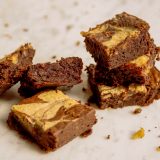Up until the late 19th century, chocolate was a rare ingredient, and chocolate desserts were mostly absent from American cookbooks. In fact, the first brownie recipe, published in 1896 in Fannie Farmer’s “The Boston Cooking-School Cook Book,” really was a molasses cake. Farmer’s 1906 version wasn’t much better: more cake than brownie, with only a faint chocolate flavor.
Today, of course, chocolate is everywhere and brownies are infinite in style, flavor and texture. But most remain one-note wonders, little more than sugar, fat and chocolate plus the occasional marshmallow, nut or swirl of peanut butter. At Milk Street, we wanted a more grown-up pairing.
We loved the halvah brownie from Tatte Bakery & Cafe in Cambridge, Massachusetts. Halvah is a fudge-like candy from the Middle East made from tahini, a rich paste of ground sesame seeds. The mix of slightly bitter sesame and chocolate appealed to us immediately.
Others had paved the way. Naomi Duguid swirls sweetened tahini into brownies made with sesame oil, while Yotam Ottolenghi adds raw tahini to brownie batter, then sprinkles halvah on top.
A Tahini Primer: What It Is and How to Use This Sesame Paste
At Milk Street, we fiddled with how much tahini to use in our brownies—its fat content was the problem. A full cup made the brownies greasy, and the tahini formed a thick layer that didn't bake well. So we reduced the tahini and the amount of butter, substituted cocoa powder for some of the chocolate and added an egg to cut through the rich brownie base. That was a good start.
Instead of adding tahini to a classic brownie batter, we reversed our thinking, stirring chocolate into a tahini base. Be sure to fully bake the brownies—they are extremely tender, even wet, if not baked through. One last tip: The tahini’s flavor and color intensify over time, so make the brownies a day ahead for a more pronounced sesame taste.
10 Clever Ways to Cook with Tahini
We’ve made these brownies dozens of times. The slight bitterness and complexity of the tahini indeed are the perfect match for chocolate. Brownies finally have come of age.
Think peanut butter with a pleasantly bitter bite. That’s tahini, a paste made from sesame seeds. It’s now widely available in the U.S. in multiple varieties. The primary difference is whether the seeds are toasted or raw. Either should have a fresh sesame flavor that’s nutty and buttery, says chef Alon Shaya, an expert in Middle Eastern cuisine.
Look for labels that list just one ingredient: sesame seeds. Shaya prefers tahinis that are stone-ground. “The stone grinding really gets the best texture and incorporates the oils and the nutrients into the actual butter.” We prefer brands from the Middle East, such as Aleppo and Al Kanater.
A layer of oil from the crushed seeds rises to the top (as with natural peanut butter), so be sure to mix tahini well to avoid oily brownies or hummus. If you use a jar in a month or so, store it tightly sealed in a cabinet. It will last even longer refrigerated.




